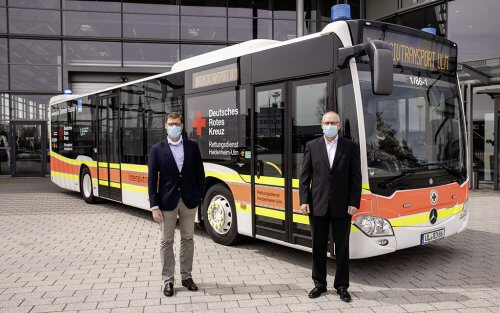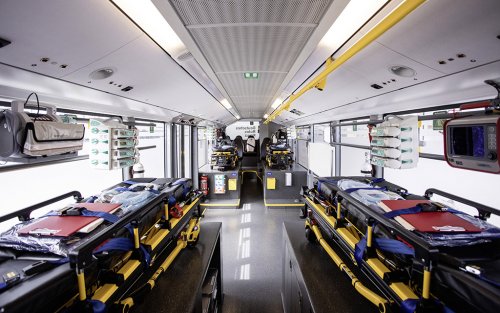Daimler Buses has converted an inter-city bus into a vehicle for the transfer of COVID-19 patients at its plant in Neu-Ulm. The Mercedes-Benz Citaro has been converted into an intensive care ambulance and is to be used by DRK Rettungsdienst Heidenheim-Ulm GmbH (German Red Cross Emergency Medical Services Heidenheim-Ulm). Initially it will be available on loan to the German Red Cross (DRK) for a period of six months. The joint project is supported by the University Hospital in Ulm which is providing the specialized medical staff and operator Stadtwerke Ulm/Neu-Ulm GmbH is providing drivers and maintenance personnel.
“Among other professions, it is currently the staff in hospitals and care facilities who are working steadfastly and who particularly deserve our respect. Therefore, I am delighted that we are able to support the DRK by supplying transportation capacity. As a bus manufacturer, we want to contribute to the fight against the COVID-19 pandemic at a local level. A diverse range of activities at the Neu-Ulm plant show that there are good initiatives and strategies from our colleagues even now,” explained Till Oberwörder, Head of Daimler Buses.

David Richter, Managing Director of DRK-Rettungsdienst Heidenheim-Ulm had the idea of converting a bus in response to the need to increase intensive care transportation capacities, now necessary in many places, and Daimler Buses was able to make this a reality. Within a few days, a demonstration vehicle from Daimler Buses’ stock was made available for conversion. Twelve employees from the bus production facility in Neu-Ulm converted the bus to a high-capacity critical care ambulance in just 15 working days, the conversion and the supply of the medical equipment being completed in close co-operation with DRK-Rettungsdienst Heidenheim-Ulm.
“The high-capacity critical care ambulance puts DRK-Rettungsdienst Heidenheim-Ulm and the doctors from Ulm’s University Hospital in a position to efficiently relieve hospitals where intensive care beds are in short supply. And not only in the Ulm/Neu-Ulm area but in other regions and states,” said David Richter, Managing Director of DRK-Rettungsdienst Heidenheim-Ulm.
Professor Kühlmuss, District Medical Officer for DRK-Rettungsdienst added: “Something that normally would take months and years was implemented within a few weeks together with Daimler Buses in an exemplary fashion. And in doing so, this is not just a bus, but an efficient transportation and relief concept. In my opinion this is only possible with such a transportation capacity.”
In place of its 45 seats and standing room for 40 more, the bus is now equipped with four complete intensive care beds. Journeys will be supervised by two intensive care doctors from the University Hospital in Ulm, joined by three paramedics and two ambulance officers supplied by DRK-Rettungsdienst Heidenheim-Ulm. The bus is equipped with four electro-hydraulic wheeled stretchers with a loading system, four intensive care ventilators, four monitoring screens, a sonography unit and a blood gas analysis device. Daimler Buses also created stowage space for sufficient medicines, nursing equipment, additional breathing apparatus and protective clothing. The vehicle has been designed so that the patients can be transported in various positions, and the side windows have been tinted for privacy. The bus has also been equipped with a blue light and a siren. To ensure complete hygiene, a disinfectant sprayer can be used in the patient compartment once transportation is completed, and the driver’s cab is separated from the patient compartment by a wall. As a result the driver has no contact with patients and is not exposed to any infection.
Gunter Czisch, Mayor of the City of Ulm, praised the initiative: “Represented by Stadtwerke Ulm/Neu-Ulm, we can be proud that we are a part of this unique pilot project. The transportation vehicle from the Daimler Buses plant in Neu-Ulm clearly shows what innovations the Ulm/Neu-Ulm region is capable of.”
Managing Director of Stadtwerke Ulm/Neu-Ulm GmbH, Klaus Eder, concluded: “For some time now SWU has been supporting numerous initiatives and aid projects in the region under the motto #WirFürEuch (UsForYou). For us, organizing the driving staff for the transportation of critical care patients and taking care of the repairs and maintenance on the vehicle is a good opportunity to help. After all we transport over 40 million passengers safely and reliably every year.”


